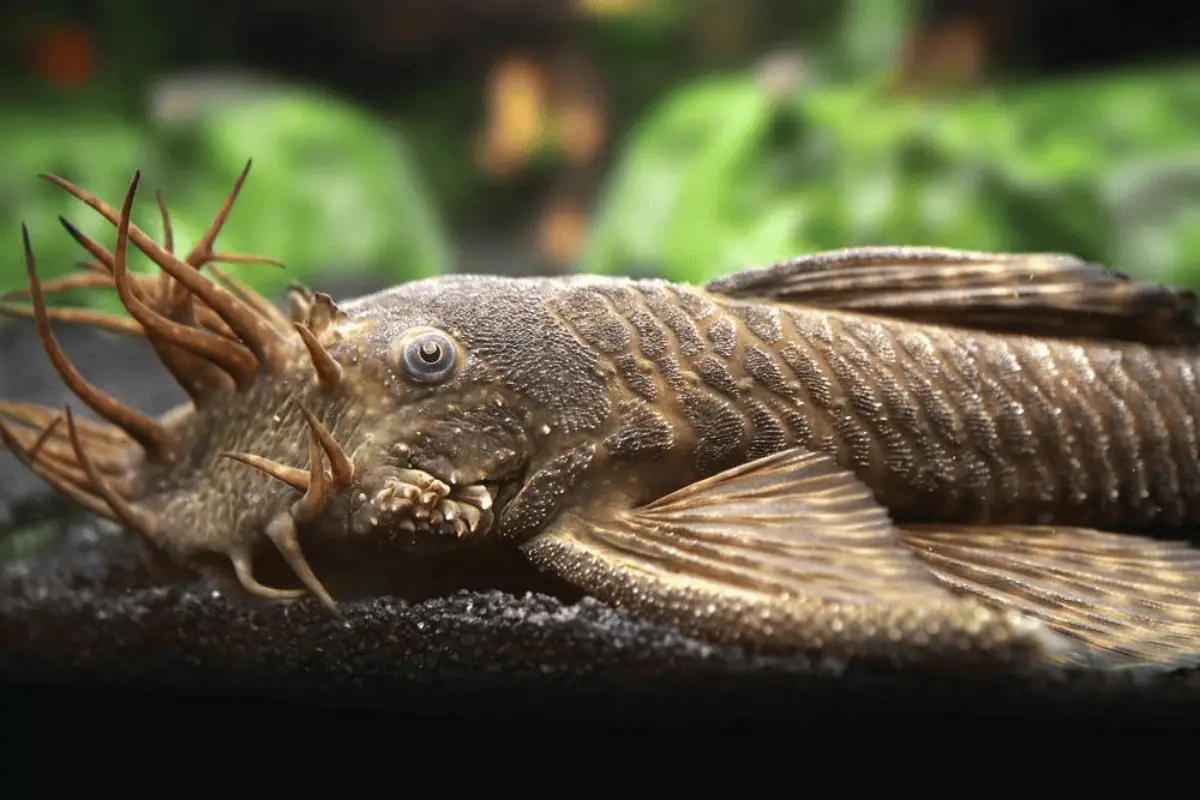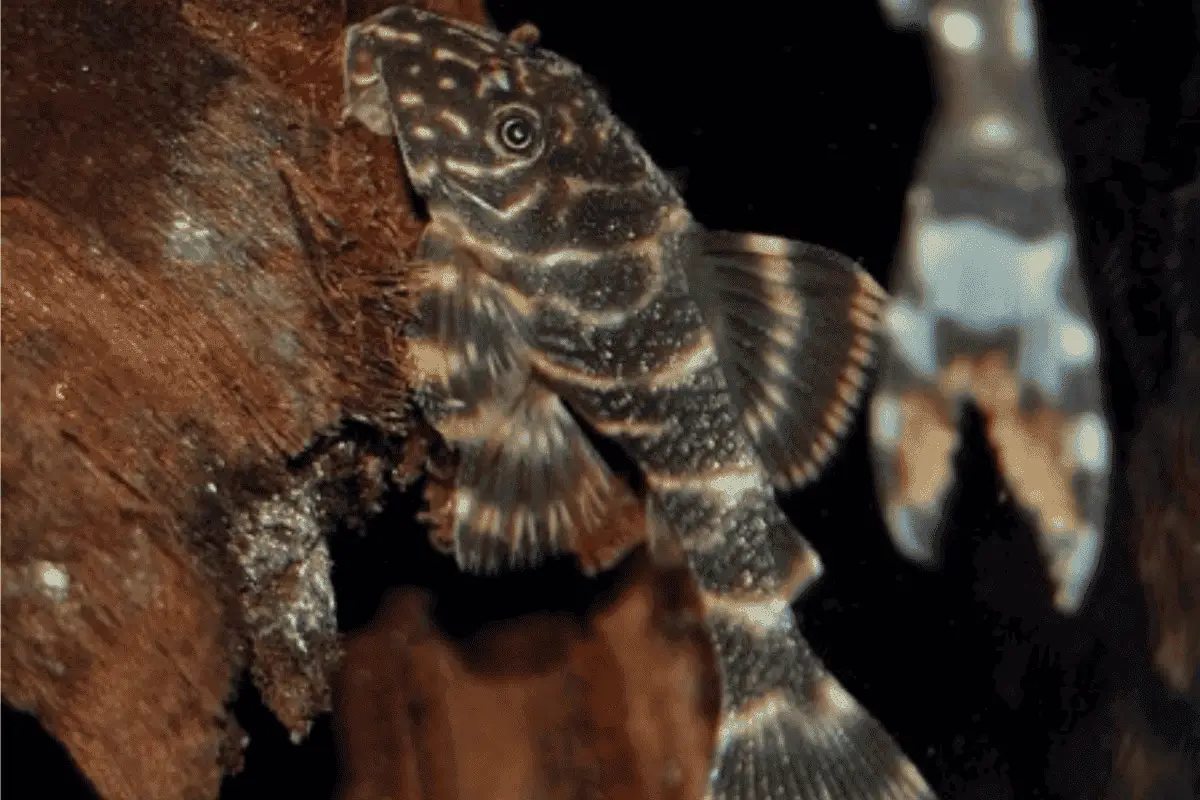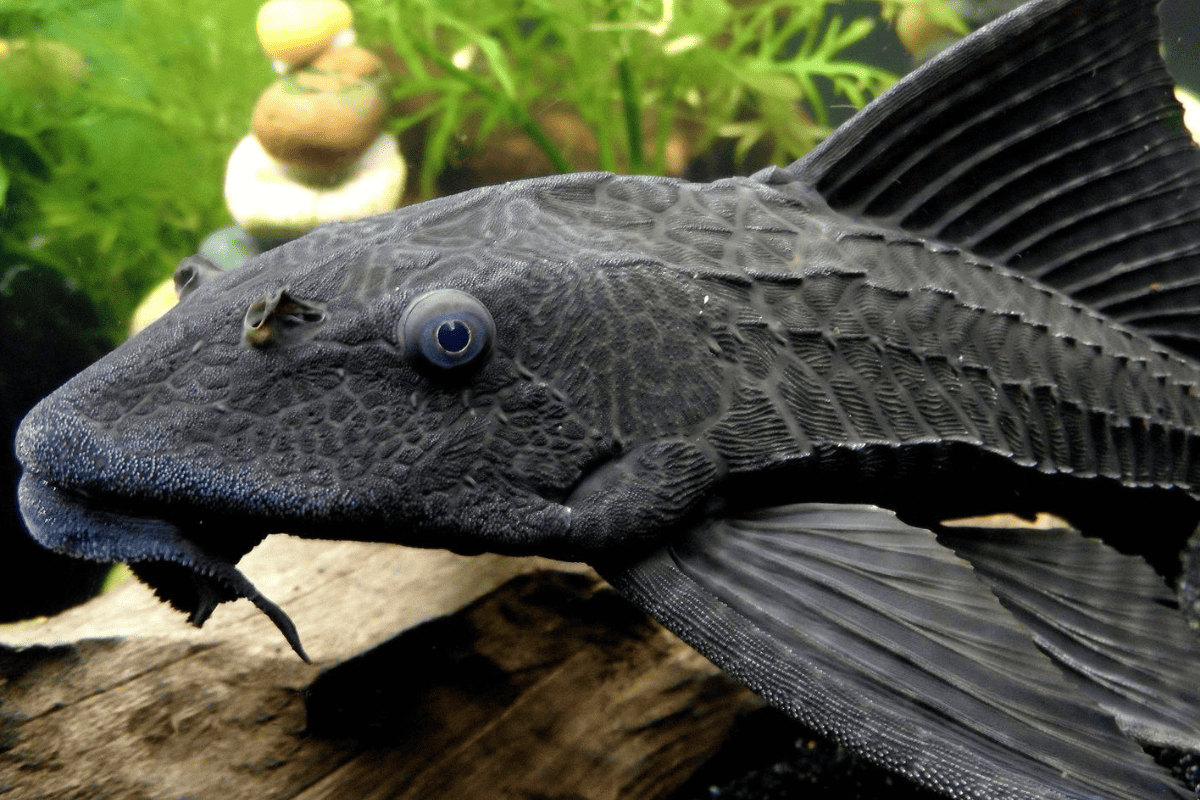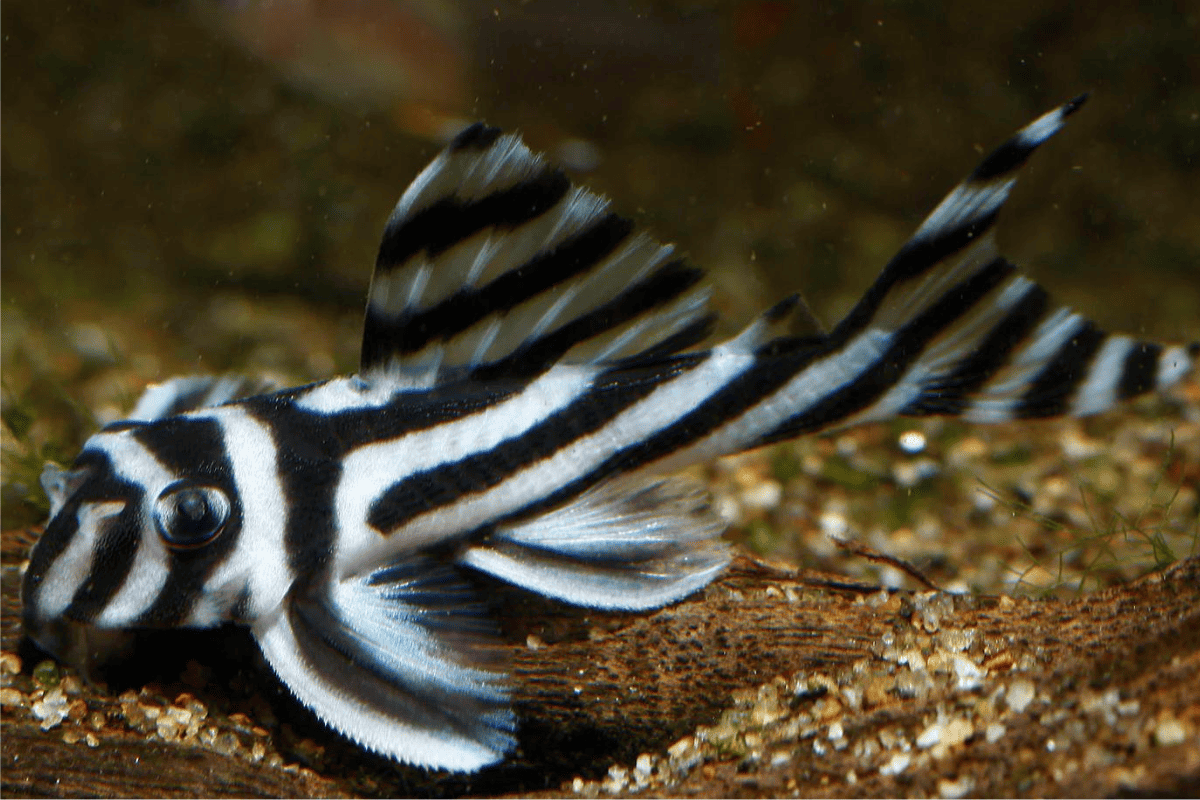We all know that Plecos are considered one of the best species for cleaning home aquariums.
But what about algae? Will Plecos help get rid of them? And if so, which algae types can be eaten by Plecos, and which Pleco species are best at eating them?
In this article, I’ll answer all these questions and more, so you leave with all the information you need. Let’s get started.

Do Plecos Eat Algae?
Yes, Plecos do eat algae. It’s one of their primary food sources in natural habitats and in aquariums.
- Variety of Plecos: There are many Pleco species, and while common Plecos love algae, Zebra Plecos might opt for more carnivorous meals.
- Types of Algae: Plecos favor green algae and brown diatoms, but often shun blue-green algae (cyanobacteria) which can be problematic.
- Size Matters: Younger Plecos are voracious algae eaters; however, as they grow, their diet often diversifies beyond just algae.
- Tank Conditions: Algae growth, influenced by light and nutrients, can affect a Pleco’s consumption; more algae usually means more grazing.
- Exceptions to the Rule: Though ideal for algae control, Plecos need a varied diet; solely relying on them for algae control can lead to malnutrition.
Also Read: What Do Plecos Eat?
What Sort of Algae Do Plecos Eat?
Here are the main kinds of algae that Plecos might eat in your aquarium:
1. Green Algae

Plecos are known to feast on green algae, which often covers the surfaces of tanks. This type of algae is their most preferred food source in aquarium settings.
- Ubiquitous Diet: Green algae is prevalent in many aquariums, and Plecos often see it as a staple in their diets.
- Tank Health: Having a Pleco to consume green algae helps in balancing the tank’s aesthetic and overall health.
- Preference: Among all the algae types, green algae is the most preferred by most Pleco species, especially the common Pleco.
2. Brown Algae (Diatoms)

Diatoms are another favorite for Plecos, especially in newer tanks. They are usually the first algae eaters go for in such setups.
- Early Stage Tanks: Diatoms often appear in new tanks, and Plecos are efficient at keeping them in check.
- Silicate Consumers: Plecos help control diatoms, which thrive on silicates in the water, making the tank environment healthier.
- Texture: The soft, easily grazable texture of diatoms makes them an appealing meal for Plecos.
3. Blue-Green Algae (Cyanobacteria)

This isn’t actual algae but a form of bacteria. Plecos aren’t typically fans of cyanobacteria, and it can be problematic in tanks.
- Non-preference: Plecos usually avoid cyanobacteria, making other methods necessary for its control.
- Potential Issues: If you notice blue-green “algae” persisting, even with Plecos, it’s a sign of other tank issues.
- Toxin Producer: Cyanobacteria can produce toxins, so it’s essential not to rely solely on Plecos for its control.
4. Black Beard Algae (BBA)

BBA is a tough algae for many fish to eat due to its coarse nature. Plecos might nibble on it but aren’t the best solution for BBA problems.
- Coarse Structure: BBA’s rough texture deters Plecos, making it less appealing than softer algae forms.
- Limited Consumption: While some Plecos might nibble on BBA, they don’t consume it as readily as green algae or diatoms.
- Alternative Control: For effective BBA management, consider other control methods besides Plecos.
5. Hair Algae

Hair algae can be a nuisance in tanks, and while some Plecos might graze on it, it’s not their first choice.
- Tangled Challenge: Hair algae’s long, stringy structure can pose a challenge for Plecos to consume efficiently.
- Partial Consumption: Some Plecos might occasionally graze on hair algae, but they aren’t the best solution for its control.
- Varied Diet: While hair algae isn’t a top pick, a Pleco’s diversified diet might still include occasional bits of it.
6. Green Spot Algae

Green spot algae forms distinct small spots, usually on glass and slow-growing plants.
While Plecos occasionally graze on them, they are not the most efficient at eradicating this stubborn algae.
- Stubborn Spots: Due to its tough nature, green spot algae can be difficult for Plecos to consume thoroughly.
- Occasional Grazing: Some Plecos might graze on it, but their efficiency is limited compared to other algae types.
- Common Appearance: Found on surfaces with high light exposure, it often signals a phosphate imbalance, and Plecos can’t address this root issue.
7. Green Dust Algae

This algae covers tank surfaces like a film of dust. Plecos do graze on green dust algae, but they might not completely clear it.
- Surface Coverage: Green dust algae usually forms a layer over tank walls, making it accessible for Plecos to graze.
- Inefficient Clearing: While Plecos will feed on it, they might not be thorough, leaving patches behind.
- Regular Maintenance: For optimal control, combine Pleco grazing with regular tank maintenance.
8. Thread Algae

Thread algae appear as long, thin strands waving in the tank’s current. Some Plecos might try to graze on them, but they’re not the best solution for this type.
- Stringy Structure: The thin, thread-like structure can be tricky for Plecos to consume efficiently.
- Occasional Consumption: Some adventurous Plecos might graze on thread algae, but it’s not a primary food source.
- Better Solutions: Other fish species or manual removal might be more effective than relying on Plecos.
9. Fuzz Algae

Resembling short tufts of hair, fuzz algae often covers plant leaves and decorations. Plecos can graze on it, but it might not be their first choice.
- Plant Affinity: Fuzz algae tends to cling to plant surfaces, sometimes making it a challenge for Plecos.
- Partial Consumption: Plecos will eat fuzz algae but might not be thorough, especially if other preferred algae types are available.
- Competitive Eating: Introducing other algae eaters can help in controlling fuzz algae more effectively alongside Plecos.
Which Pleco Species Eat Algae?
Most Pleco species have an affinity for algae and consider it a primary food source in their diet.
However, the extent to which they consume algae varies across species, largely depending on their mouth structure, natural habitat, and dietary needs.
- Mouth Structure: Plecos with broad, flat mouths, often referred to as “suckermouths,” are well-adapted to graze on algae covering surfaces like glass, rocks, and plants in the aquarium.
- Natural Habitat: Plecos hailing from environments rich in algae, such as streams or riverbeds, typically have a stronger inclination towards algae consumption in captivity.
- Dietary Needs: While many Plecos rely on algae as a primary food source, others have diversified diets, incorporating more proteins and thus showing less dependency on algae alone.
Here’s a simple table showing whether a specific Pleco species is likely to eat algae:
| Pleco Species | Eats Algae? |
| Rubber Lip Pleco | Yes |
| Clown Pleco | Yes |
| Snowball Pleco | Yes |
| Bulldog Pleco | Yes |
| Royal Pleco | Yes |
| Bristlenose Pleco | Yes |
| King Tiger Pleco | Yes |
| Medusa Pleco | Yes |
| Blue Phantom Pleco | Yes |
| Spotted Rubber Nose Pleco | Yes |
| Panaque Pleco | Yes |
| Gold Nugget Pleco | Yes |
| Emperor Pleco | Yes |
| Sunshine Pleco | Yes |
| Whiptail Pleco | Yes |
| Common Pleco | Yes |
| Green Phantom Pleco | Yes |
| Leopard Frog Pleco | Yes |
| Red Fin Cactus Pleco | Yes |
| Mango Pleco | Yes |
| Rhino Pleco | Yes |
| Zebra Pleco | No |
| Flash Pleco | No |
| Vampire Pleco | No |
| Scarlet Pleco | No |
| Peppermint Pleco | No |
| Galaxy Pleco | No |
| Pseudacanthicus Pleco | No |
| Titan Pleco | No |
| Thunder Line Pleco | No |
| Adonis Pleco | No |
Are Plecos the Best Algae Eaters?
No, while Plecos are efficient algae eaters, they might not always be the best option for every aquarium.
There are other aquatic creatures that can outperform Plecos in specific algae-eating scenarios.
- Size and Diet Diversity: As Plecos grow, they often diversify their diet and may consume less algae, focusing on other food sources.
- Otocinclus Catfish: These small fish are voracious algae eaters and can be more efficient in smaller aquariums than Plecos, especially for green algae.
- Shrimps: Creatures like Amano shrimp and Cherry shrimp are excellent for consuming hair and film algae, often reaching spaces Plecos can’t.
- Snails: Some snail species, like the Nerite snail, are algae-eating champions, removing algae from glass, decorations, and even plants.
- Siamese Algae Eaters: Highly sought after for their ability to eat stubborn Black Beard Algae (BBA), they often outperform Plecos in dealing with this specific algae type.
Which Plecos Are Best at Cleaning Your Tank?
Here are a few of the top-performing Pleco species for keeping your tank clean:
1. Bristlenose Pleco (Ancistrus sp.)

A top choice for many aquarists, Bristlenose Plecos are diligent cleaners known to thrive in various environments. Their compact size makes them perfect for smaller tanks.
- Versatility: Bristlenose Plecos can adapt to a range of water conditions and are often chosen for community tanks.
- Size Advantage: Growing only up to 4-6 inches, they’re ideal for tanks starting from 30 gallons.
- Algae Preference: They are particularly fond of green algae, often seen scouring tank walls and decorations.
2. Rubber Lip Pleco (Chaetostoma formosae)

Another compact cleaner, Rubber Lip Plecos have a varied diet but are especially effective against algae.
- Biofilm Consumers: Beyond algae, they’ll consume biofilm, benefiting overall tank health.
- Tank Size: Typically growing up to 7 inches, a 30-gallon tank or larger is ideal.
- Decorative Scavenging: These Plecos are often seen cleaning rocks and driftwood thoroughly.
3. Clown Pleco (Panaqolus maccus)

More than just algae eaters, Clown Plecos are also wood grazers, adding a unique cleaning dimension.
- Wood Requirement: Having driftwood is essential, as they derive nutrients from consuming it.
- Small Size: Growing up to 3.5 inches, they’re suitable for smaller aquarium setups.
- Lesser Algae Consumption: While they eat algae, their preference for wood means less algae consumption than others.
4. Common Pleco (Hypostomus plecostomus)

Often the first thought for many, Common Plecos are great cleaners but grow very large.
- Growth Consideration: They can grow over 12 inches, requiring spacious tanks (often 100 gallons or more).
- Dietary Shift: Younger Common Plecos consume more algae, but diversify their diet as they mature.
- Efficient but Bulky: Their large size means they clean efficiently, but they also produce substantial waste.
5. Zebra Pleco (Hypancistrus zebra)

A stunning fish, Zebra Plecos are more carnivorous and less efficient algae eaters.
- Protein Preference: Their diet leans towards meaty foods, making them less focused on algae.
- Distinct Appearance: Their striking pattern makes them more of a show fish than a cleaner.
- Special Care: Preferring warmer waters, Zebra Plecos require specific tank conditions.
6. Snowball Pleco (Hypancistrus inspector)

Similar to the Zebra, Snowball Plecos are also more carnivorous, with a penchant for protein-rich foods.
- Dietary Needs: They love worms, crustaceans, and other protein sources over algae.
- Distinctive Markings: With attractive patterns, they’re another decorative addition to tanks.
- Moderate Size: Growing up to 6 inches, they need moderately sized tanks.
7. Bulldog Pleco (Chaetostoma miles)

A robust cleaner, the Bulldog Pleco is adept at navigating rocky substrates and effectively removing algae.
- Rocky Habitats: Originating from rocky streams, they’re skilled at cleaning such structures in tanks.
- Temperatures: They prefer cooler water temperatures, making them suitable for certain setups.
- Versatile Diet: While algae-centric, they do appreciate occasional protein treats.
Will a Pleco Keep My Tank Clean?
No, while Plecos are proficient at consuming algae, solely relying on them for tank cleanliness is mistaken. Plecos can assist, but they can’t replace regular maintenance.
- Diverse Diets: Many Plecos diversify their diets with growth; they might consume less algae and more pellets or vegetables.
- Waste Production: Mature Plecos produce significant waste, adding to substrate debris and increasing water nitrates.
- Tank Maintenance: Regular water changes, gravel cleaning, and filter checks remain crucial, even with a Pleco’s presence.
How to Encourage a Pleco to Eat Algae from Your Tank
To encourage a Pleco to eat algae from your tank, you should make the environment ideal and the Pleco’s nutritional needs balanced.
It’s essential to make algae an accessible and appealing food source for the Pleco.
- Limit Alternative Foods: If you’re feeding Plecos wafers or veggies daily, reduce this to 2-3 times a week. This limitation encourages them to seek out tank algae for sustenance.
- Optimal Lighting: A light cycle of about 8-10 hours daily promotes healthy algae growth without causing an overabundance. Adjustments can be made based on algae growth rate.
- Introduce Algae Wafers Sparingly: Use these wafers once a week, ensuring Plecos don’t rely solely on them. They should view natural algae as their primary food source.
- Tank Cleanliness: Regularly clean the tank but leave some algae patches. For instance, during monthly cleans, leave some algae on tank walls or decorations to give Plecos an obvious target.

What Are the Benefits of Having a Pleco in an Aquarium?
Having a Pleco in an aquarium offers several advantages, extending beyond their renowned algae-eating capabilities.
These fish not only contribute to a cleaner environment but also offer significant advantages for your aquarium.
- Natural Cleanup Crew: Plecos efficiently eat decaying vegetation and leftover food, reducing the risk of ammonia spikes.
- Decorative Appeal: Plecos bring a unique beauty to aquariums with their distinct patterns, shapes, and sizes. For example, the Zebra Pleco’s captivating stripes can be a focal point.
- Low Aggression: The majority of Pleco species are peaceful, allowing them to peacefully share space with different tank buddies and promoting positive community vibes.
- Biofilm Control: Plecos naturally feed on biofilm, making sure surfaces don’t become excessively slippery or overrun, which might harm certain water plants.
Also Read: Do Plecos Eat Plants?
Do Plecos Need Algae Wafers?
Indeed, although Plecos eat algae by instinct, they thrive with the added nutrients from algae wafers, especially in tanks where natural algae is scarce.
Algae wafers make sure Plecos get all the crucial nutrients they need to flourish.
- Balanced Diet: Algae wafers provide a well-rounded nutrient combination. While algae is beneficial, it may not supply every nutrient a growing Pleco requires.
- Insufficient Algae: In tanks with limited algae, wafers serve as a backup food source, ensuring Plecos aren’t left hungry.
- Diversified Intake: As Plecos grow, their dietary preferences can shift. Offering wafers now and then can meet these diverse needs.

Why Did My Pleco Stop Eating Algae?
Several factors could cause your Pleco to stop eating algae, from health issues to evolving food tastes. Pinpointing the reason is essential for resolution.
- Tank Conditions: Keep water conditions in check. A sudden change, like an ammonia rise, might suppress their hunger.
- Health Issues: Like all fish, Plecos can get sick. Watch for signs of discomfort or illness and see a vet if necessary.
- Dietary Shift: As Plecos age, they often broaden their diet. Consider adding different foods like vegetables or specially crafted Pleco feeds.
- Algae Availability: Make sure there’s enough algae. If lacking, think about less frequent tank cleaning or using lights to foster natural algae development.
Conclusions
For quick readers, here’s a brief overview:
- Plecos excel at eating algae, marking them as essential in aquariums for controlling both green algae and brown diatoms.
- Different Pleco species have varying tastes for algae, with some leaning towards meat, while others focus on algae.
- Plecos might not be the go-to for handling blue-green algae (cyanobacteria) because of their disinclination and potential toxin release.
- Even though Plecos are great at eating specific algae types, they require a varied diet to avoid undernourishment.
- Other water critters like Otocinclus Catfish, shrimps, snails, and Siamese Algae Eaters may surpass Plecos in certain algae-eating tasks and are worth considering for holistic tank care.
